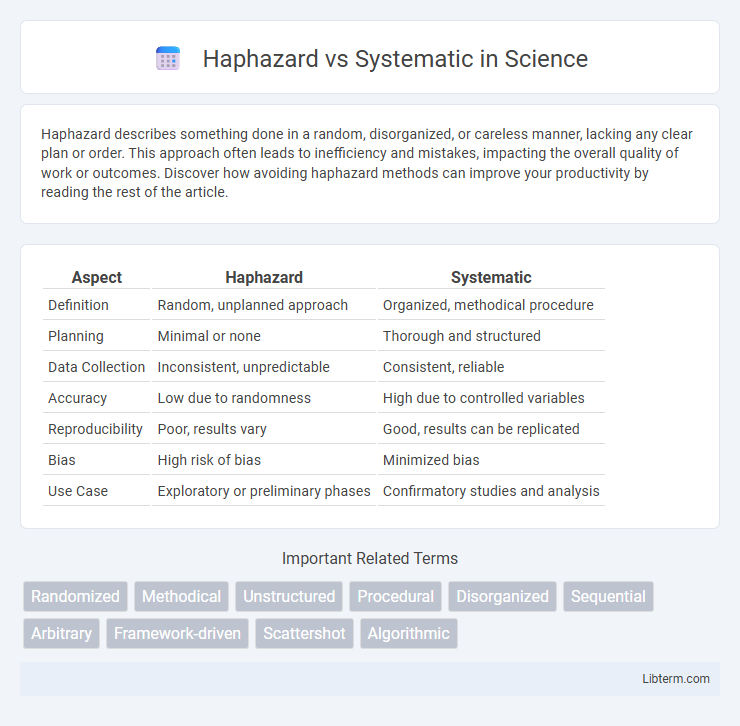Haphazard describes something done in a random, disorganized, or careless manner, lacking any clear plan or order. This approach often leads to inefficiency and mistakes, impacting the overall quality of work or outcomes. Discover how avoiding haphazard methods can improve your productivity by reading the rest of the article.
Table of Comparison
| Aspect | Haphazard | Systematic |
|---|---|---|
| Definition | Random, unplanned approach | Organized, methodical procedure |
| Planning | Minimal or none | Thorough and structured |
| Data Collection | Inconsistent, unpredictable | Consistent, reliable |
| Accuracy | Low due to randomness | High due to controlled variables |
| Reproducibility | Poor, results vary | Good, results can be replicated |
| Bias | High risk of bias | Minimized bias |
| Use Case | Exploratory or preliminary phases | Confirmatory studies and analysis |
Introduction: Defining Haphazard and Systematic
Haphazard refers to actions or processes carried out without planning, organization, or a clear method, often resulting in inconsistent and unpredictable outcomes. Systematic involves a structured and methodical approach that follows a specific plan or set of procedures to achieve consistent and reliable results. Understanding the distinction between haphazard and systematic methods is crucial for improving efficiency and effectiveness in research, decision-making, and project management.
Key Differences Between Haphazard and Systematic Approaches
Haphazard approaches lack organization and planning, often leading to inconsistent results and inefficiency, while systematic approaches follow structured, methodical procedures that ensure reliability and repeatability. The key difference lies in predictability; systematic methods rely on clear protocols and data-driven decision-making, whereas haphazard methods depend on ad hoc choices without established guidelines. Systematic approaches optimize resource use and minimize errors, contrasting sharply with the random, often ineffective nature of haphazard efforts.
Pros and Cons of Haphazard Methods
Haphazard methods offer flexibility and speed by allowing decisions without strict planning or structure, making them useful in dynamic environments where rapid responses are critical. However, these methods often lead to inconsistency, increased risk of errors, and lack of reproducibility, which can undermine long-term effectiveness and reliability. The absence of systematic guidelines may result in overlooked details and inefficiencies, reducing overall quality and accountability in processes.
Benefits of Systematic Strategies
Systematic strategies provide a structured approach that enhances efficiency by minimizing errors and reducing redundancies. They enable better resource allocation through consistent processes and clear objectives, leading to improved decision-making and measurable outcomes. The predictability and repeatability of systematic methods foster long-term success and scalability in complex projects.
Real-World Examples: Haphazard vs Systematic
Haphazard approaches often lead to inconsistent results, such as businesses launching products without market research, causing poor customer reception and lost revenue. Systematic methods, like Toyota's Lean Manufacturing, rely on structured processes and continuous improvement, resulting in higher efficiency and quality control. In disaster response, a systematic plan coordinates resources and communication, whereas a haphazard effort may cause delays and resource misallocation.
Impact on Efficiency and Effectiveness
Haphazard approaches result in inconsistent outcomes and frequent errors, significantly reducing operational efficiency and overall effectiveness. Systematic methods implement structured processes and repeatable steps, leading to optimized resource use and enhanced performance consistency. Businesses adopting systematic workflows often experience higher productivity, improved quality control, and better alignment with strategic goals.
Risk Management: Haphazard vs Systematic
Haphazard risk management involves inconsistent identification and mitigation of risks, often leading to overlooked vulnerabilities and reactive responses. Systematic risk management employs structured frameworks like COSO or ISO 31000 to proactively assess, prioritize, and control risks with continuous monitoring and documentation. Organizations utilizing systematic approaches typically experience improved risk visibility, compliance adherence, and resilience against operational disruptions.
Choosing the Right Approach for Your Goals
Choosing the right approach between haphazard and systematic methods depends on your specific goals and context. Systematic strategies provide structured, consistent processes ideal for achieving long-term objectives and minimizing errors, while haphazard methods may suit exploratory or creative tasks requiring flexibility and spontaneity. Assessing project scope, desired outcomes, and resource availability ensures alignment with the most efficient approach for optimal results.
Transitioning from Haphazard to Systematic
Transitioning from haphazard to systematic approaches involves implementing structured processes and consistent methodologies to enhance efficiency and predictability. Establishing clear goals, standardizing workflows, and utilizing data-driven decision-making enable organizations to move away from random actions toward repeatable, optimized results. This shift improves resource allocation, reduces errors, and fosters continuous improvement in operations.
Conclusion: Why Systematic Wins in the Long Run
Systematic approaches consistently yield higher accuracy and reliability by following structured methodologies and predefined criteria. Haphazard methods often result in errors, inefficiencies, and missed opportunities due to randomness and lack of organization. Organizations that adopt systematic processes experience improved decision-making, resource optimization, and sustainable success over time.
Haphazard Infographic

 libterm.com
libterm.com